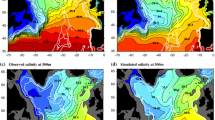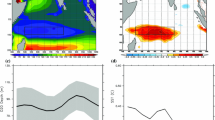Abstract
This study aims at understanding the summer ocean-atmosphere interactions in the North Atlantic European region on intraseasonal timescales. The CNRMOM1d ocean model is forced with ERA40 (ECMWF Re-Analysis) surface fluxes with a 1-h frequency in solar heat flux (6 h for the other forcing fields) over the 1959–2001 period. The model has 124 vertical levels with a vertical resolution of 1 m near the surface and 500 m at the bottom. This ocean forced experiment is used to assess the impact of the North Atlantic weather regimes on the surface ocean. Composites of sea surface temperature (SST) anomalies associated with each weather regime are computed and the mechanisms explaining these anomalies are investigated. Then, the SST anomalies related to each weather regime in the ocean-forced experiment are prescribed to the ARPEGE Atmosphere General Circulation Model. We show that the interaction with the surface ocean induces a positive feedback on the persistence of the Blocking regime, a negative feedback on the persistence of the NAO-regime and favours the transition from the Atlantic Ridge regime to the NAO-regime and from the Atlantic Low regime toward the Blocking regime.










Similar content being viewed by others
References
Belamari S (2005) Report on uncertainty estimates of an optimal bulk formulation for surface turbulent fluxes. Marine EnviRonment and Security for the European Area—Integrated Project (MERSEA IP), Deliverable D4.1.2, 29 pp
Belamari S, Pirani A (2007) Validation of the optimal heat and momentum fluxes using the ORCA2-LIM global ocean-ice model. Marine EnviRonment and Security for the European Area—Integrated Project (MERSEA IP), Deliverable D4.1.3, 88 pp
Bernie DJ, Woolnough SJ, Slingo JM, Guilyardi E (2005) Modeling diurnal and intraseasonal variability of the ocean mixed layer. J Clim 18:1190–1202
Bernie DJ, Guilyardi E, Madec G, Slingo JM, Woolnough SJ (2007) Impact of resolving the diurnal cycle in an ocean-atmosphere GCM. Part 1: a diurnally forced OGCM. Clim Dyn 29:575–590
Bougeault P, Lacarrere P (1989) Parameterization of orography-induced turbulence in mesobeta-scale model. Mon Wea Rev 117:1872–1890
Cassou C, Terray L, Hurrell JW, Deser C (2004a) North Atlantic winter climate regimes: spatial asymmetry, stationarity with time, and oceanic forcing. J Clim 17:1055–1068
Cassou C, Deser C, Terray L, Hurrell JW, Drévillon M (2004b) Summer sea surface temperature conditions in the North Atlantic and their impact upon the atmospheric circulation in early winter. J Clim 17:3349–3363
Cassou C, Terray L, Phillips A (2005) Tropical Atlantic influence on European heat waves. J Clim 18:2011–2805
Caniaux G, Belamari S, Giordani H, Paci A, Prieur L, Reverdin G (2005) A 1 year sea surface heat budget in the northeastern Atlantic basin during the POMME: experiment 2. Flux optimization. J Geophys Res 110:C07S03. doi:10.1029/2004JC002695
Cayan DR (1992a) Latent and sensible heat flux anomalies over the Northern Oceans: driving the sea surface temperature. J Phys Oceanogr 22:859–881
Cayan DR (1992b) Latent and sensible heat flux anomalies over the northern oceans: the connection to monthly atmospheric circulation. J Clim 5:354–369
Czaja A, Frankignoul C (1999) Influence of the North Atlantic SST on the atmospheric circulation. Geophys Res Lett 26:2969–2972
Czaja A, Frankignoul C (2002) Observed impact of Atlantic SST anomalies on the North Atlantic Oscillation. J Clim 15:606–623
Danabasoglu G, Large WG, Tribbia JJ, Gent PR, Briegleb BP, McWilliams JC (2006) Diurnal coupling in the tropical oceans of CCSM3. J Clim 19:2347–2365
De Boyer Montégut C, Madec G, Fischer AS, Lazar A, Ludicone D (2004) Mixed layer depth over the global ocean: an examination of profile data and a profile based climatology. J Geophys Res 109:12003. doi:10.1029/2004JC002378
Déqué M, Braun A, Piedelievre J-P, Marquet P, Dandin P, Guérémy J-F, Geleyn J-F, Bazile E, Piriou J-M, Yessad K, Courtierand P, Rochas P (1999) ARPEGE version 3, documentation algorithmique et mode d’emploi (in French, available from CNRM/GMGEC, Météo-France, 42 avenue G. Coriolis, 31057 Toulouse, France)
Douville H, Royer J-F, Mahfouf J-F (1995a) A new snow parametrization for the Météo-France climate model. Part I: Validation in stand-alone experiments. Clim Dyn 12:21–35
Douville H, Royer J-F, Mahfouf J-F (1995b) A new snow parametrization for the Météo-France climate model. Part II: Validation in a 3-D GCM experiments. Clim Dyn 12:37–52
Drévillon M, Terray L, Rogel P, Cassou C (2001) Midlatitude Atlantic SST influence on European winter climate variability in the NCEP–NCAR Reanalysis. Clim Dyn 18:331–344
Drévillon M, Cassou C, Terray L (2003) Model study of the wintertime atmospheric response to fall tropical Atlantic SST anomalies. Quart J Roy Meteor Soc 129:2591–2611
Gaspard P, Gregoris Y, Lefevre J-M (1990) A simple eddy kinetic energy model for simulations of the oceanic vertical mixing: tests at station Papa and long-term upper ocean study site. J Geophys Res 95(C9):16179–16193
Gibelin AL, Déqué M (2003) Anthropogenic climate change over the Mediterranean region simulated by a global variable resolution model. Clim Dyn 20:327–339
Gibson JK, Kallberg P, Uppala S, Hernandez A, Nomura A, Serrano E (1997) ERA description. ECMWF Reanalysis Project Report Series No.1, European Centre for Medium-range Weather Forecasts, Reading, UK, 66 pp
Giordani H, Caniaux G, Prieur L (2005a) A simplified 3D oceanic model assimilating geostrophic currents: application to the POMME experiment. J Phys Oceanogr 35:628–644
Giordani H, Caniaux G, Prieur L, Paci A, Giraud S (2005b) A 1 year mesoscale simulation in the northeast Atlantic: mixed layer heat and mass budgets during the POMME experiment. J Geophys Res 110:C07S08. doi:10.1029/2004JC002765
Giordani H, Prieur L, Caniaux G (2006) Advanced insights into sources of vertical velocity in the ocean. Ocean Dyn 56:513–514
Grötzner A, Latif M, Barnett TP (1998) A decadal climate cycle in the North Atlantic Ocean as simulated by the ECHO coupled GCM. J Clim 11:831–847
Hoerling MP, Hurrell JW, Xu T (2001) Tropical origins for recent North Atlantic climate change. Science 292:90–92
Hoskins BJ, Sardeshmukh PD (1987) A diagnostic study of the dynamics of the northern hemisphere winter of 1985–1986. Quart J Roy Meteor Soc 113:759–778
Hurrel JW, Kushnir Y, Ottersen G, Visbeck M (2003) An overview of the North Atlantic Oscillation. The North Atlantic Simulation: climate significance and environmental impacts, Geophys. Monogr., No. 134, Amer. Geophys. Union, pp 1–22
Jerlov NG (1976) Marine optics. Elsevier, Amsterdam, 229 pp
Latif M, Arpe K, Roeckner E (2000) Oceanic control of decadal North Atlantic sea level pressure variability in winter. Geophys Res Lett 27:727–730
Mahfouf JF, Manzi A, Noilhan J, Giordani H, Déqué M (1995) The land surface Scheme ISBA within the Météo-France climate model ARPEGE. Part I. Implementation and preliminary results. J Clim 8:2039–2057
Masson V, Champeaux JL, Chauvin F, Meriguet C, Lacaze R (2003) A global database of land surface parameters at 1 km resolution in meteorological and climate models. J Clim 16:1261–1282
Maykut GA (1982) Large-scale heat exchange and ice production in the Central Arctic. J Geophys Res 87:7971–7984
Mehta V, Suarez M, Manganello JV, Delworth TD (2000) Oceanic influence on the North Atlantic Oscillation and associated Northern Hemisphere climate variations: 1959–1993. Geophys Res Lett 27:121–124
Michelangeli PA, Vautard R, Legras B (1995) Weather regimes: recurrence and quasi stationarity. J Atmos Sci 52:1237–1256
Namias J (1964) Seasonal persistence and recurrence of European blocking during 1958–1960. Tellus 16:394–407
Ohlmann JC (2003) Ocean radiant heating in climate models. J Clim 16:1337–1351
Paulson CA, Simpson JJ (1977) Irradiance measurements in the upper ocean. J Phys Oceanogr 7:952–956
Ramos Buarque S, Giordani H, Caniaux G, Planton S (2004) Evaluation of ERA-40 air–sea surface heat flux spin-up. Dyn Atmos Oceans 37:295–311
Rayner NA, Parker DE, Horton EB, Folland CK, Alexander LV, Rowell DP, Kent EC, Kaplan A (2003) Global analyses of sea surface temperature, sea ice, and night marine air temperature since the late nineteenth century. J Geophys Res 108(14):4407. doi:10.1029/2002JD002670
Reynolds RW, Rayner NA, Smith TM, Stokes DC, Wang W (2002) An improved in situ and satellite SST analysis for climate. J Clim 15:1609–1625
Reynolds RW, Smith TM, Liu C, Chelton DB, Casey KS, Schlax MG (2007) Daily high-resolution blended analyses for sea surface temperature. J Clim 20:5473–5496
Robertson AW, Mechoso CR, Kim YJ (2000) The influence of Atlantic sea surface temperature anomalies on the North Atlantic oscillation. J Clim 13:122–138
Rodwell MJ, Rowell DP, Folland CK (1999) Oceanic forcing of the wintertime North Atlantic Oscillation and European climate. Nature 398:320–323
Salas-Mélia D (2002) A global coupled sea ice-ocean model. Ocean Model 4:137–172
Salas-Mélia D, Chauvin F, Déqué M, Douville H, Gueremy JF, Marquet P, Planton S, Royer JF, Tyteca S (2005) Description and validation of the CNRM-CM3 global coupled model, CNRM technical report 103 (Available from CNRM/GMGEC, 42 ave. G.Coriolis, 31057 Toulouse, France or http://www.cnrm.meteo.fr/scenario2004/paper_cm3.pdf)
SanchezGomez E, Terray L (2005) Large-scale atmospheric dynamics and local intense precipitation episodes. Geophys Res Lett 32:L24711. doi:10.1029/2005GL023990
Shinoda T (2005) Impact of the diurnal cycle of solar radiation on intraseasonal SST variability in the Western Equatorial Pacific. J Clim 18:2628–2636
Shinoda T, Hendon HH (1998) Mixed layer modeling of intraseasonal variability in the tropical western Pacific and Indian Oceans. J Clim 11:2668–2685
Simonsen K, Haugan PM (1996) Heat budgets of the Arctic Mediterranean and sea surface heat flux parameterizations for the Nordic Seas. J Geophys Res 101:6553–6576
Steele M, Morley R, Ermold W (2001) PHC: a global ocean hydrography with a high quality Arctic Ocean. J Clim 14:2079–2087
Terray L, Cassou C (2002) Tropical Atlantic Sea surface temperature forcing of quasi-decadal climate variability over the North Atlantic-European region. J Clim 15:3170–3187
Uppala S, Kallberg P, Hernandez A, Saarinen S, Fiorino M, Li X, Onogi K, Sokka N, Andrae U, da Costa Bechtol V (2004) ERA-40: ECMWF 45-year reanalysis of the global atmosphere and surface conditions 1957–2000. ECMWF Newsl 101:2–21
Acknowledgments
This work formed part of a PhD. Thesis at the Centre National de Recherches Météorologiques, Toulouse, funded by Météo-France and the Commissariat à l’Energie Atomique (CEA). The authors wish to thank Soline Bielli for her help in applying the weather regime classification and Pascal Terray and Eric Maisonnave for the availability of their statistical package STATPACK. The two anonymous reviewers are greatly acknowledged for their interesting suggestions. This study was supported by the European Commission’s 6th Framework Programme (ENSEMBLES, contract GOCE-CT-2003-505539).
Author information
Authors and Affiliations
Corresponding author
Additional information
An erratum to this article can be found at http://dx.doi.org/10.1007/s00382-010-0771-9
Rights and permissions
About this article
Cite this article
Guemas, V., Salas-Mélia, D., Kageyama, M. et al. Summer interactions between weather regimes and surface ocean in the North-Atlantic region. Clim Dyn 34, 527–546 (2010). https://doi.org/10.1007/s00382-008-0491-6
Received:
Accepted:
Published:
Issue Date:
DOI: https://doi.org/10.1007/s00382-008-0491-6




